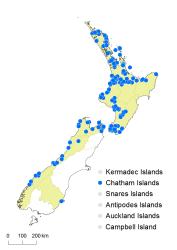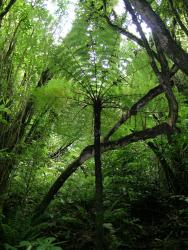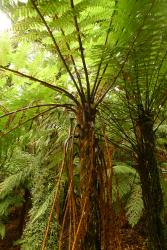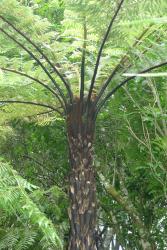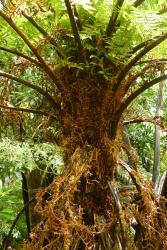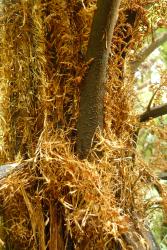- ≡ Alsophila cunninghamii (Hook.f.) R.M.Tryon, Contr. Gray Herb. 200: 36 (1970)
Rhizomes erect, forming a woody trunk up to c. 20 m tall, 50–200 mm in diameter or rarely up to 280 mm in well-grown plants, covered in dark brown to black appressed stipe bases in the upper part of the trunk, and stipe scars in the lower part; bearing scales near the apex. Rhizome scales marginate, narrowly ovate, lacking dark-coloured setae, pale brown. Fronds 1500–3000 mm long, held horizontally; dead fronds usually falling, but often persistent in immature plants. Stipes 80–450 mm long, 12–45 mm wide and 7–35 mm deep at the base, black proximally, becoming black-brown or red-brown distally, tuberculate and rough, bearing hairs and scales; hairs fine, acicular, colourless or pale brown, up to 1 mm long; scales narrowly ovate, pale brown throughout or with dark brown centres, densely covering base of stipe, up to 50 mm long and 1–2 mm wide, becoming more scattered distally, interspersed with dense red acaroid scales c. 0.1 mm in diameter, sometimes with small expanded bases. Laminae deeply 2-pinnate-pinnatifid to 3-pinnate-pinnatifid, ovate or elliptic or obovate, 1400–2750 mm long, 420–1000 mm wide, dark green above, paler below, herbaceous or coriaceous; adaxial surfaces of rachis, pinna midribs, costae and rarely the laminae abundantly covered in fine, acicular, colourless or pale brown hairs up to 1 mm long, and scattered, narrowly ovate, pale brown scales; abaxial surfaces very rarely bearing scattered curled acicular hairs, but bearing abundant pale scales with bullate bases and attenuate apices sometimes with a red apical seta, up to 5 mm long and 1 mm wide, and abundant colourless or red acaroid scales, 0.1–0.2 mm long, sometimes with a small expanded base c. 1 mm long; rachis red-brown, becoming yellow-brown distally, finely tuberculate. Primary pinnae in 20–30 pairs, narrowly ovate or narrowly triangular or narrowly elliptic; the longest at or above the middle, 270–600 mm long, 80–210 mm wide, short-stalked; the lowermost pair often greatly reduced and distant from the next pair up. Secondary pinnae narrowly ovate or narrowly triangular, the longest 43–110 mm long, 9–28 mm wide, short-stalked or sessile. Longest tertiary pinnae 5–15 mm long, 1.5–3 mm wide, adnate; apices acute; margins entire, crenate or divided up to ⅔ to the midrib. Sori 0.5–0.9 mm in diameter; paraphyses shorter than sporangia, or absent; indusia open on side away from costa before maturity, hood-shaped at maturity and forming more than a hemisphere, splitting on upper surface with age.
On the main islands of New Zealand Cyathea cunninghamii is most easily confused with C. medullaris. It is distinguished by its slender trunk covered in appressed stipe bases rather than hexagonal scars, shorter (up to 3 m long cf. up to 5 m long) and rather lacy fronds, thinner and rougher stipes (up to 45 mm wide and 35 mm deep cf. up to 90 mm wide and 60 mm deep), stipe scales that lack marginal setae, and hood-shaped rather than irregularly splitting indusia. Cyathea cunninghamii differs from C. smithii in lacking a skirt of persistent dead fronds when mature, and having hood-shaped rather than saucer-shaped indusia. These three species can also be distinguished by the form of their lamina scales (Brownsey 1979).
Cyathea cunninghamii is morphologically very similar to C. kermadecensis. The two taxa share indusia which open at maturity to form a hood-shape, and a diverse array of very similar hairs and scales on the abaxial surface of the laminae. No other taxa in New Zealand or Australia have indusia of this type or such a diversity of scales and hairs. However, C. kermadecensis has a greater abundance of large pale brown scales on the abaxial surfaces of the costae than C. cunninghamii, and scattered, irregularly curled, acicular hairs on the abaxial costae, which are usually absent in C. cunninghamii. C. kermadecensis also lacks the red acaroid scales of C. cunninghamii, producing only colourless acaroid scales with slightly longer branches. The tertiary pinnae of C. cunninghamii are slightly more divided, and the stipe bases of C. kermadecensis are red-brown rather than black as in C. cunninghamii. The status of the two species has been discussed by Brownsey & Perrie (2015). They are very closely related but are retained here as species in the absence of any definitive evidence to the contrary.
North Island: Northland, Auckland, Volcanic Plateau, Gisborne, Taranaki, Southern North Island.
South Island: Western Nelson, Sounds-Nelson, Westland, Otago, Fiordland.
Chatham Islands.
Altitudinal range: 0–950 m.
Cyathea cunninghamii occurs throughout coastal and lowland areas in the damper western part of the North Island, extending locally to montane regions of southern Coromandel, and the Kaimai, Ruahine and Tararua Ranges. It is largely absent from the drier east coast. It occurs from sea level up to 800 m on Mt Pirongia, and 950 m on Mt Te Aroha. In the South Island it is confined to coastal and lowland areas in the Marlborough Sounds, north-west Nelson and Westland as far south as Poison Bay in northern Fiordland, with an isolated record on the east coast from Half Way Bush, Dunedin. It occurs from sea level up to about 200 m, and has also been collected from the Chatham Islands.
Also occurs in Australia (Queensland, New South Wales, Victoria, Tasmania). It is known from single populations in south-east Queensland and south-east New South Wales, and is largely confined to Victoria and Tasmania. It hybridises with C. australis, and the hybrid is known as C. ×marcescens (Peacock et al. 2013).
Brownsey (1979) noted that Cyathea cunninghamii "…appears to favour damp gullies or river banks in lowland forested areas, particularly where there are fresh soils or there is frequent deposition of detritus and silt". It is a tall, emergent species recorded from podocarp and broadleaved forest, kānuka forest, wetland forest, and occasionally from silver beech forest, or under Pinus radiata. It also occurs in coastal forest and sometimes with nikau in the South Island. It is susceptible to drought (Brownsey 1979) and is rare in the eastern parts of both main islands. It is locally common in damper areas of the North Island, such as along the Whanganui River.
2n = 138 (Murray & de Lange 2013).
Colenso’s No. 1780, chosen as the lectotype of Cyathea cunninghamii by Tindale (1956), was sent to W.J. Hooker in a letter initially dated 29 September 1848 and closed on 20 October. In the letter, Colenso stated "1780. Incipient fronds sprouting from a prostrate (felled) caudex, side of road. Caudex 9 feet long. Cyathea pulcherissima, W.C." (St. George 2009).




